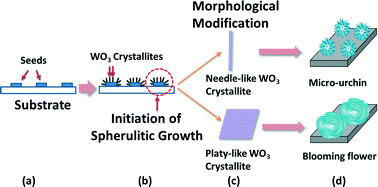Electrochromic performance of WO3 films: optimization by crystal network topology modification
Abstract
In this study, we demonstrate the enhancement of the electrochromic performance of tungsten oxide (WO3) by crystal network topology modification. This is achieved by constructing various crystalline morphologies and patterns of the films. Different mesoscopic crystalline networks of WO3 were acquired on transparent conducting fluorine-doped tin oxide (FTO) by a crystal-seed-assisted hydrothermal process. The modification of the crystal network topology and crystal growth habit of WO3 films was achieved by adding different concentrations of oxalic acid and HCl, and controlling the growth time. The influence of the topological patterns on the corresponding electrochromic performance of WO3 films was examined by scanning electron microscopy (SEM), transmission electron microscopy (TEM), X-ray photoelectron spectroscopy (XPS), X-ray diffraction (XRD) and in situ reflectance spectroscopy. It follows that four different topological patterns of WO3 microstructures, namely random “rocks” of the seed layers, micro-urchin, small peony, and blooming peony were obtained by adding different concentrations of oxalic acid and hydrochloric acid. It is found that pH and oxalic acid are both the key modifying factors of the habit and topology of the crystal networks. Consequently, the urchin-like pattern gives rise to a high efficiency in optical modulation and coloration due to its similarity to micro-sized antennas, which may facilitate the emission and absorption of charged particles and electrochemical reactions at the WO3 surfaces.



 Please wait while we load your content...
Please wait while we load your content...